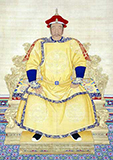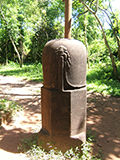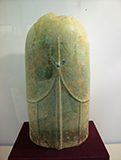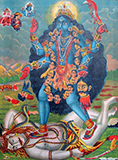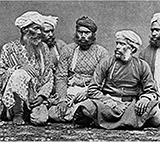Temple of Doom
Raiders of the Lost Ark | Temple of Doom | Last Crusade
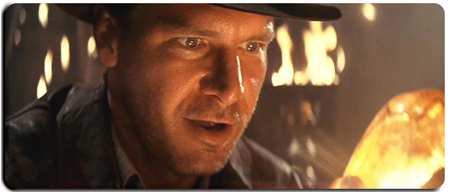
In Temple of Doom, Indiana Jones unknowingly begins a journey that will take him through a living hell involving mystical stones, child slavery, and the Hindu goddess Kali. Little archaeology is seen in the film, but nonetheless, Indiana Jones discovers some interesting treasures while on this dark journey. Much like Raiders of the Lost Ark, the story of Temple of Doom is based in certain truths.
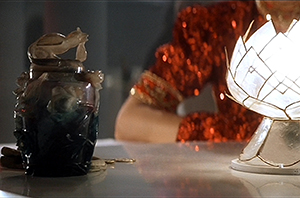
Nurhaci
As Temple of Doom begins, Indiana Jones has found his way to Shanghai and the Club Obi-Wan where he is negotiating with Chinese gangster, Lao Che over the remains of Nurhaci, the “first emperor of the Manchu Dynasty.” It is revealed that Nurhaci’s remains have been cremated and placed inside a small, but ornate urn made of jade. As the deal concludes, Indy discovers he has unsuspectingly consumed poison and a comical fight begins that introduces us to Indy’s new companions, Willie Scott and Short Round.
Nurhaci was a real Manchu chieftain born in 1559. He is best known for his military campaigns that united numerous Jurchen tribes and for conquering Northeast China. Nurhaci’s land acquisitions would allow his descendants to conquer the rest of China and form the Qing Dynasty.
Nurhaci also created the Eight Banners, an administrative and military system that divided the Manchu families. The Eight Banners helped Nurhaci and his descendants gain control of China and remained their instrumental military organization until the mid-19th Century when modern weaponry made them obsolete. Despite this, the banner system remained until the fall of the Qing Dynasty in 1911. Before his death in 1626, Nurhaci also developed a written script for the Manchu language.
Urns are used to store the cremated or incinerated remains of dead bodies. Archaeological evidence reveals the use of urns in the Middle East and Europe as early as the Neolithic Age (10,000 BC – 2,000 BC approx.). An urn is typically made of a ceramic or stone material and decorated according to a person’s status, wealth, or lifestyle and ranges in size from very small to very large. Cremation is still a common form of burial found throughout the world today.
Jade was likely used for Nurhaci’s urn as it was the Imperial gem of China and was considered more valuable than gold or silver.
Learn More
-CCTV: Channel 9- Nurhaci Documentary-CCTV: Channel 9- About Nurhaci
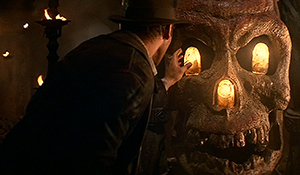
Sankara Stones
Indy and his companions literally fall from the heavens into a desolate Indian village called Mayapore. The unusual travelers are viewed by the locals as gifts from Shiva and are invited into the village where it is revealed their children have been kidnapped and their sacred Sankara Stone has been stolen by men from nearby Pankot Palace. Realizing the dire need of the village, Indy agrees to help them recover their children and sacred Sankara Stone.
The name Sankara is another term for the Hindu deity, Shiva. It comes from Adi Shankara, who lived during the 8th Century AD and was named Shankara after Shiva. Some Hindus believe that Adi Shankara was an avatar or earthly incarnation of Shiva. The god Shiva is one of the three primary Hindu gods (the Trimurti) and is considered the Destroyer. Although he is the Destroyer, which seems harsh or vengeful, Shiva is also the bringer of new life as reincarnation or rebirth comes from destruction.
The actual Sankara Stone that Indy is searching for may not be real, but the use of similar stones called Lingam or Shiva-Linga in the Hindu religion is quite common. A lingam is a representation of Shiva and used for worship in Hindu temples. Debate exists amongst Hindus as to whether or not the lingam is merely a representation of the deity or a spiritual presence of Shiva.
Another debate surrounds the lingam and its true purpose or meaning. Some see the lingam as a phallic symbol while others view it as a source of spiritual energy. Lingam are usually linked with a yoni, which is a symbol of Shakti (female creative energy). This tie makes many people view the lingam as a representation of male and female and their inseparability in creation.
The origination of worshiping lingam can be traced back to the Hindu scripture of Shiva Purana where Shiva loses and recovers his phallus. The pillar or lingam is also thought to represent the beginning-less and endless nature of Shiva.
Learn More
-Shiva Linga-Encyclopedia Britannica: Lingam
-What is a Shiva Linga?
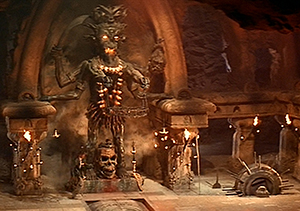
Kali
After an interesting, but formal dinner with the Maharajah, Indy discovers a hidden and deadly passage beneath Pankot Palace. Together with Willie and Short Round, the trio makes its way through a series of death traps to eventually find a Thuggee worship service in progress. Listening to the chanting, Indy realizes the Thuggee are worshiping the Hindu goddess, Kali.
Kali is an actual deity found in the Hindu religion. The goddess is often referred to as the “the black one” because she is believed to be the entity of time. Sometimes she is called “the black mother” due to her designation as both a giver and destroyer of life.
As with many Hindu gods and goddesses, Kali’s role is somewhat debatable and depends greatly on one’s specific faith. Some Hindus associate Kali with death and violence (as the Thuggee would), while others see her as an annihilator of evil. Kali is also viewed as Bhavatārini, the redeemer of the universe. Ultimately, she is the goddess of time and change.
Kali is typically viewed as the consort of Shiva, the Destroyer. Hindu art often depicts Kali as standing on Shiva, which suppresses his anger. Kali is also considered to be the primary goddess among the ten Tantric goddesses.
Learn More
-Encyclopedia Mythica: Kali-Kali: The Dark Mother
-Encyclopedia Britannica: Kali
-Killing for 'Mother' Kali
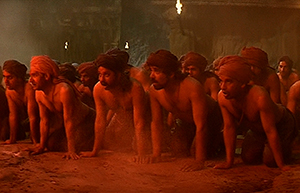
Thuggee
At the same formal dinner where "snake surprise" and "chilled monkey brains" are part of the meal, Indiana Jones finds himself discussing the extinct Thuggees with the Maharajah, his prime minister Chattar Lal and other dinner guests. Unfortunately for Indy, the Thuggees and their worship of Kali, devotion to human sacrifice, and their devouring of blood will prove to be all too real.
The Thuggees are greatly fictionalized in Temple of Doom, but like much of the story, there is truth behind Indy’s adventure. In actuality, the Thuggee were a religious cult and group of bandits who travelled across India killing travelers. The Thuggee were active for several hundred years and as stated in the film, were eventually squashed by the persistent British in the mid 1800’s. The Thuggee were known to join travelers (sometimes for hundreds of miles), gain their confidence over time and then murder them at an opportune moment. Thugs were known to strangle their victims (quiet and not as messy) and then loot the travelers’ possessions.
The number of Thuggee killings ranges from fifty thousand to two million. One Thuggee named Behram once claimed to have killed over 900 people. Due to inconsistencies in his story, the exact number he killed cannot be known. However, one can certainly assume the number of murders Behram committed was great. Still, Behram is considered by many to be history's most prolific serial killer.
Thuggee worship of Kali was also real, however the extent and ultimate religious nature of the killings has been debated. In many instances, it is thought the Thuggee actively killed travelers as sacrifices to Kali, believing that they were avoiding her wrath on all mankind by satiating her need of destruction. Today, it is more commonly believed that the Thuggee had few religious ties and were merely bandits who violently murdered to gain wealth.
By the 1830’s, the British colonization of India was leading to the demise of the Thuggee. Through their methodical evaluation of the mysterious disappearances of travelers, the British caught on to the Thuggee’s systematic and cautious methods of murder and thievery. British officials warned the various provinces of the Thuggees and their methods, leading to fewer attacks. The British also used a primitive police force to record and examine the attacks, as well as offering clemency to members who came forward with names of other Thugs. The Thuggees could no longer safely or gainfully operate and eventually disbanded.
An instrumental person in the destruction of the Thuggee was Sir William Henry Sleeman, a British soldier and superintendent in colonial India. It was Sleeman who captured a Thug named “Feringhea” and convinced him to turn King’s Evidence or snitch on his cohorts. Thanks to Sleeman’s efforts, the Thuggee were revealed and the British began their famed suppression of the deadly cult.
Learn More
-Who were the Thugs of India?Wagner, Kim A. Thuggee: Banditry and the British in Early Nineteenth-Century India. Palgrave Macmillan, 2007.
Dash, Mike. Thug: The True Story of India's Murderous Cult. Granta Books, 2005.
Van Woerkens, Martine. The Strangled Traveler: Colonial Imaginings and the Thugs of India. University Of Chicago Press, 2002.
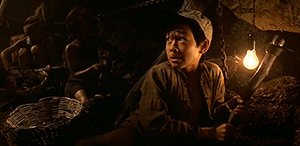
Child Slavery
As noted above, Indiana Jones discovers that the children of Mayapore have been kidnapped by individuals from Pankot Palace. Later, as he retrieves the Sankara Stones deep below the palace, Indy overhears the familiar sound of cracking whips, but disturbingly accompanied by the cries and screams of children. Further investigation reveals that the children of the village have been enslaved and forced to mine below the palace in search of the final Sankara Stone.
Slavery has been around for thousands of years and has been instituted by some of the most well-known and progressive civilizations of human history. The institution of slavery constitutes a person becoming the property of someone else and forced to labor without compensation. Child slavery has also been a mainstay to the institution of involuntary servitude and has historically existed as a hereditary means of gaining additional slaves in many cultures. There is also historical evidence of families selling their children into slavery as compensation for debts or as penance for crimes.
Although slavery has been abolished throughout most of the world, the exploitation of children as a free labor source continues. Today, most child slavery exists in Third World countries where economies are weak, government is corrupt or non-existent, poverty is wide spread, and individual freedom rarely exists.
Learn More
-How to Buy a Child in 10 Hours-What is child labour?
-Tracking Africa's child trafficking
-UN fears rising child sex trade
Disclaimer: All resources (including books and websites) provided on indyintheclassroom.com are intended to be used by educators. Indyintheclassroom.com is not responsible for the content on linked websites.
Copyright: All images on Indyintheclassroom.com are used with permission or are in the public domain. Exceptions are noted. For additional information see our Copyright section. |
Raiders of the Lost Ark | Temple of Doom | Last Crusade

